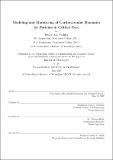| dc.contributor.advisor | George C. Verghese and Thomas Heldt. | en_US |
| dc.contributor.author | Parlikar, Tushar Anil, 1978- | en_US |
| dc.contributor.other | Massachusetts Institute of Technology. Dept. of Electrical Engineering and Computer Science. | en_US |
| dc.date.accessioned | 2008-03-26T21:08:54Z | |
| dc.date.available | 2008-03-26T21:08:54Z | |
| dc.date.copyright | 2007 | en_US |
| dc.date.issued | 2007 | en_US |
| dc.identifier.uri | http://hdl.handle.net/1721.1/40859 | |
| dc.description | Thesis (Ph. D.)--Massachusetts Institute of Technology, Dept. of Electrical Engineering and Computer Science, 2007. | en_US |
| dc.description | This electronic version was submitted by the student author. The certified thesis is available in the Institute Archives and Special Collections. | en_US |
| dc.description | Includes bibliographical references (p. 231-239). | en_US |
| dc.description.abstract | In modern intensive care units (ICUs) a vast and varied amount of physiological data is measured and collected, with the intent of providing clinicians with detailed information about the physiological state of each patient. The data include measurements from the bedside monitors of heavily instrumented patients, imaging studies, laboratory test results, and clinical observations. The clinician's task of integrating and interpreting the data, however, is complicated by the sheer volume of information and the challenges of organizing it appropriately. This task is made even more difficult by ICU patients' frequently-changing physiological state. Although the extensive clinical information collected in ICUs presents a challenge, it also opens up several opportunities. In particular, we believe that physiologically-based computational models and model-based estimation methods can be harnessed to better understand and track patient state. These methods would integrate a patient's hemodynamic data streams by analyzing and interpreting the available information, and presenting resultant pathophysiological hypotheses to the clinical staff in an effcient manner. In this thesis, such a possibility is developed in the context of cardiovascular dynamics. The central results of this thesis concern averaged models of cardiovascular dynamics and a novel estimation method for continuously tracking cardiac output and total peripheral resistance. This method exploits both intra-beat and inter-beat dynamics of arterial blood pressure, and incorporates a parametrized model of arterial compliance. We validated our method with animal data from laboratory experiments and ICU patient data. | en_US |
| dc.description.abstract | (cont.) The resulting root-mean-square-normalized errors -- at most 15% depending on the data set -- are quite low and clinically acceptable. In addition, we describe a novel estimation scheme for continuously monitoring left ventricular ejection fraction and left ventricular end-diastolic volume. We validated this method on an animal data set. Again, the resulting root-mean-square-normalized errors were quite low -- at most 13%. By continuously monitoring cardiac output, total peripheral resistance, left ventricular ejection fraction, left ventricular end-diastolic volume, and arterial blood pressure, one has the basis for distinguishing between cardiogenic, hypovolemic, and septic shock. We hope that the results in this thesis will contribute to the development of a next-generation patient monitoring system. | en_US |
| dc.description.statementofresponsibility | by Tushar Anil Parlikar. | en_US |
| dc.format.extent | 239 p. | en_US |
| dc.language.iso | eng | en_US |
| dc.publisher | Massachusetts Institute of Technology | en_US |
| dc.rights | M.I.T. theses are protected by
copyright. They may be viewed from this source for any purpose, but
reproduction or distribution in any format is prohibited without written
permission. See provided URL for inquiries about permission. | en_US |
| dc.rights.uri | http://dspace.mit.edu/handle/1721.1/7582 | en_US |
| dc.subject | Electrical Engineering and Computer Science. | en_US |
| dc.title | Modeling and monitoring of cardiovascular dynamics for patients in critical care | en_US |
| dc.type | Thesis | en_US |
| dc.description.degree | Ph.D. | en_US |
| dc.contributor.department | Massachusetts Institute of Technology. Department of Electrical Engineering and Computer Science | |
| dc.identifier.oclc | 212626465 | en_US |
